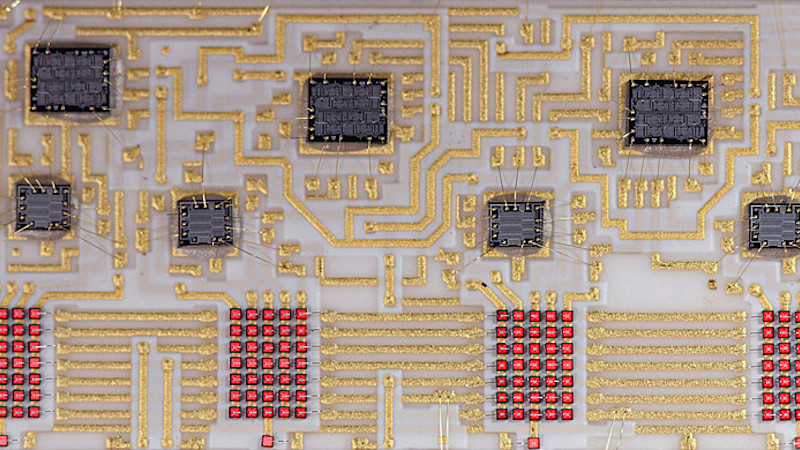Providing a display for a project in 2020 is something of a done deal. Standard interfaces and off-the-shelf libraries for easily available and cheap modules mean that the hardest choice you’ll have to make about a display will probably relate to its colour. Three decades ago though this was not such a straightforward matter though, and having a display that was in any way complex would in varying proportion take a significant proportion of your processing time , and cost a fortune. [AnubisTTP] has an unusual display from that era, a four-digit LED dot matrix module, and the take of its reverse engineering makes for a fascinating read.
The LITEF 104267 was made in 1986, and is a hybrid circuit in a metal can with four clear windows , one positioned over each LED matrix. Inside are seven un-encapsulated chips alongside the LED matrices on a golf plated hybrid substrate. The chips themselves are not of a particularly high-density process, so some high-resolution photography was able to provide a good guess at their purpose. A set of shift registers drive the columns through buffers, while the rows are brought out to a set of parallel lines. Thus each column can be illuminated sequentially with data presented on the rows. It’s something that would have saved a designer of the day a few extra 74-series chips, though we are guessing at some significant cost.
This display may seem antiquated to us today, but it wasn’t the only option for 1980s designers. There’s one display driver from back then that’s very much still with us today.
















“golf plated hybrid substrate”
Interesting…
Amusing also if you imagine nanomachine robots with #2 woods whacking gold atoms at it one by one.
oh yes !
That’s a “double” because it probably should be hyphenated: “golf-plated”…
Oh, and “… and the take of its reverse engineering makes for a …” that “take” should probably be “tale”. :-)
my irc friend once told me that he can tell whether i’m typing on a keyboard or a phone.
Autocorrect.*
*Till that comes to PC.
Its already here, Gramarly and Chrome has a rudimentary one
Yes you can tern won on and duck up yore typing any thyme you like.
I was curious about that myself; had to Google to see it it was slang for some process used in making golf clubs. Or maybe a misspelled slang for a process used in drilling equipment used in gulfs. Only thing I could find is that you can have your golf clubs gold plated, and you should probably put a license plate on your vw gold before driving it. :)
Must be FR-fore!
Those 5x7s are REALLY far apart. I would guess that they typically had a lens placed over each LED matrix.
1970s and 80s displays were ALL tradeoffs – every display had advantages and disadvantages. Here we see quite small characters, and probably not all that bright, either. And since it operated at low voltage and had built-in drivers and even a character generator, chances are this was fabulously expensive. I know the HP single-character modules like this were at least an order of magnitude more expensive than simple LED matrices.
nice site actually. has a lot of information, including for my 1p21 photo multiplier, warning me not to power the device up under normal light conditions as it can detect a single photon.
now to find a project for that tube…
It was the raysistor that caught my eye first.
you shouldn’t really expose the PMT to bright light even when unpowered…the photocathode is very delicate ;-)
It looks like it would make a nice watch, if you strapped a huge battery and an RTC to it.
The pendulum might make it … “unpractical” ;-)
Apropos of nothing this is Jenny List’s 1337 article…